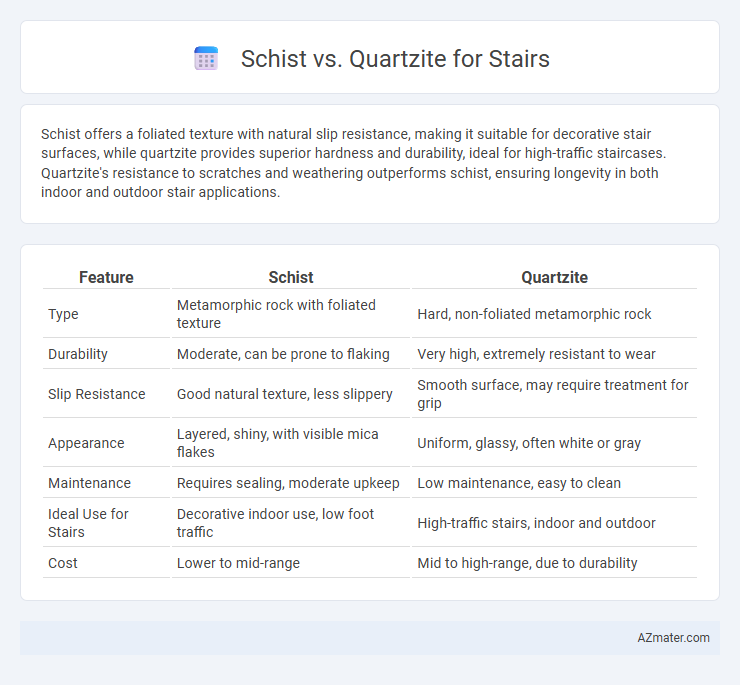Schist offers a foliated texture with natural slip resistance, making it suitable for decorative stair surfaces, while quartzite provides superior hardness and durability, ideal for high-traffic staircases. Quartzite's resistance to scratches and weathering outperforms schist, ensuring longevity in both indoor and outdoor stair applications.
Table of Comparison
| Feature | Schist | Quartzite |
|---|---|---|
| Type | Metamorphic rock with foliated texture | Hard, non-foliated metamorphic rock |
| Durability | Moderate, can be prone to flaking | Very high, extremely resistant to wear |
| Slip Resistance | Good natural texture, less slippery | Smooth surface, may require treatment for grip |
| Appearance | Layered, shiny, with visible mica flakes | Uniform, glassy, often white or gray |
| Maintenance | Requires sealing, moderate upkeep | Low maintenance, easy to clean |
| Ideal Use for Stairs | Decorative indoor use, low foot traffic | High-traffic stairs, indoor and outdoor |
| Cost | Lower to mid-range | Mid to high-range, due to durability |
Introduction to Schist and Quartzite
Schist is a metamorphic rock characterized by its foliated texture and abundant mica content, making it visually appealing with shimmering layers often used in decorative stair applications. Quartzite, formed from the recrystallization of sandstone under intense heat and pressure, is a highly durable and hard metamorphic rock ideal for stairs requiring strength and resistance to wear. Both stones offer unique aesthetic and functional benefits, with schist providing a distinctive textured appearance and quartzite delivering superior hardness and longevity.
Key Characteristics of Schist
Schist is a foliated metamorphic rock characterized by its pronounced layering and platy mineral grains, primarily mica, which provide a shimmering appearance and moderate flexibility. Unlike quartzite, schist tends to be less dense and softer, making it more prone to scratching and weathering but easier to cut and shape for intricate stair designs. Its key characteristics include excellent thermal resistance and natural slip resistance, which are beneficial for stair safety and durability in both indoor and outdoor applications.
Key Characteristics of Quartzite
Quartzite is a highly durable and dense metamorphic rock formed from sandstone under intense heat and pressure, making it ideal for stairs with heavy foot traffic. It features a smooth, glassy surface with high resistance to scratching, heat, and chemical damage, outperforming schist, which tends to be softer and more prone to flaking. Quartzite's natural range of white, gray, and subtle pastel colors provides aesthetic versatility while maintaining structural integrity and low maintenance requirements.
Durability Comparison for Stair Use
Quartzite offers superior durability for stair applications due to its high hardness and resistance to abrasion, making it ideal for high-traffic areas. Schist, while attractive with its foliated texture, is generally softer and more prone to splitting under heavy use, which may compromise long-term performance on stairs. The dense, non-foliated structure of quartzite enhances its strength and longevity, ensuring safer and more resilient stair surfaces compared to schist.
Aesthetic Differences: Color and Texture
Schist exhibits a distinctive layered texture with sparkling mica inclusions, offering a rustic and dynamic appearance that often features earthy shades such as gray, green, and brown. Quartzite presents a smoother, more uniform texture with a glassy finish, typically showcasing lighter colors like white, cream, and soft pastels, resulting in a sleek and elegant look. The color vibrancy and texture contrast make schist ideal for bold, natural designs, while quartzite suits modern, minimalist stair aesthetics.
Slip Resistance and Safety Considerations
Schist offers better slip resistance for stairs due to its rough, textured surface that provides natural grip, making it safer in wet or high-traffic areas. Quartzite, although harder and more durable, has a smoother finish that can become slippery when polished, posing a higher risk for falls. For stair safety, choosing schist reduces slip hazards, especially in environments prone to moisture or heavy foot traffic.
Installation and Maintenance Requirements
Schist and quartzite both offer durable options for stair installation, but quartzite requires professional cutting due to its hardness, while schist is easier to shape but more prone to flaking. Maintenance of quartzite stairs is minimal, needing only periodic sealing to preserve its natural resistance to stains and scratches, whereas schist demands more frequent sealing and careful cleaning to prevent accumulation of dirt in its foliated layers. Choosing quartzite for stairs ensures long-lasting structural integrity with lower upkeep, while schist offers aesthetic appeal at the cost of increased maintenance efforts.
Cost Analysis: Schist vs Quartzite
Schist typically costs less than quartzite, making it a budget-friendly option for stair installations without compromising natural stone aesthetics. Quartzite, known for its exceptional hardness and durability, commands a higher price due to its superior resistance to wear and minimal maintenance needs. When comparing long-term expenses, quartzite may offer cost savings despite the initial investment, as it reduces the frequency of repairs and replacements.
Best Applications: Where Each Stone Excels
Quartzite is ideal for stairs in high-traffic areas due to its exceptional hardness, durability, and resistance to abrasion, making it perfect for commercial and outdoor applications. Schist excels in decorative applications, offering unique foliated textures and a visually striking appearance suitable for accent staircases or interior residential settings where aesthetic appeal is prioritized over extreme durability. Both stones require sealing but quartzite's low porosity provides better stain resistance, enhancing its suitability for staircases exposed to heavy wear and moisture.
Conclusion: Choosing the Right Stone for Your Stairs
Schist offers a unique, textured appearance with excellent slip resistance ideal for indoor staircases requiring a natural aesthetic, while quartzite provides superior durability and hardness suitable for high-traffic areas and outdoor stairs. Quartzite's resistance to heat, scratches, and weathering makes it a low-maintenance option, whereas schist requires more care due to its layered structure and potential flaking. Selecting quartzite ensures long-lasting performance, while schist is preferred for decorative, less exposed stair installations.

Infographic: Schist vs Quartzite for Stair
 azmater.com
azmater.com